How to make Manhattan-style Fermented Pickles with Garlic and Dill! An easy step-by-step guide to making the most flavorful, crunchy, tangy pickles full of healthy probiotics with only 20 minutes of hands-on time! The pickle brine is like a “tonic” -drink a shot daily to support a healthy gut! Video.
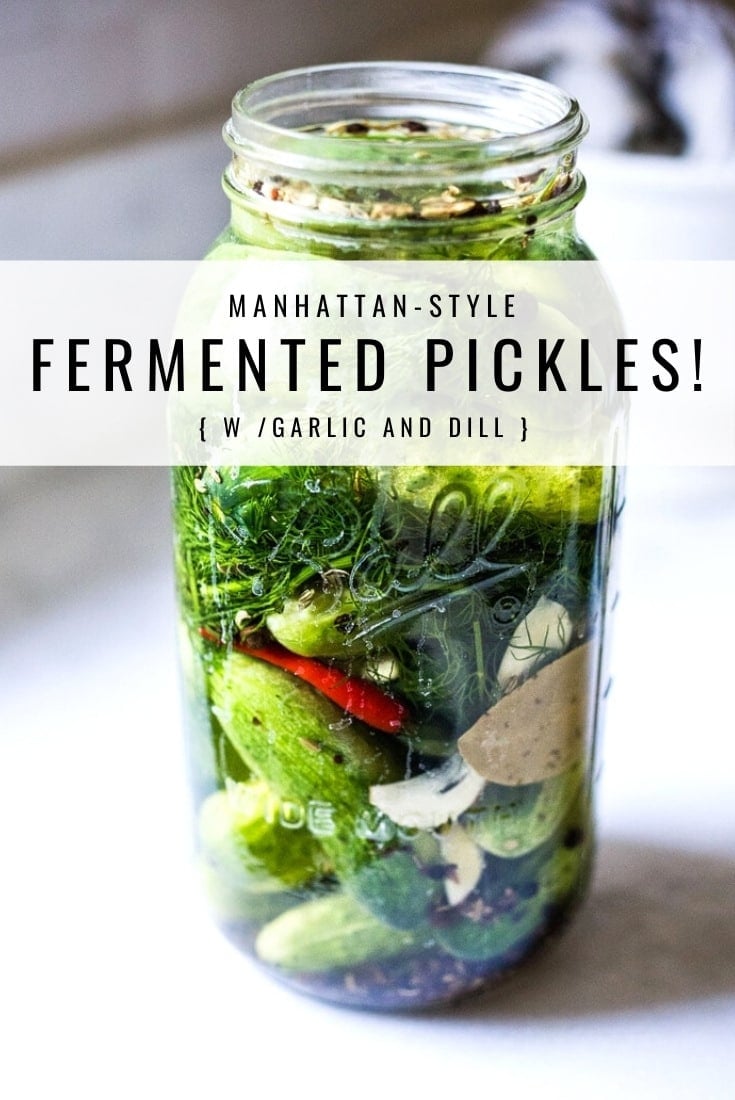
What happens when people open their hearts? They get better. ~Haruki Murakami
I’m excited to share this easy recipe for Fermented Pickles with you! If you are a crunchy pickle lover like me, you will be in heaven. Seriously, these are the best! These Manhattan-style “half-sour” fermented dill pickles are crispy, crunchy, flavorful, and oh-so alive!
Fermented in a salt brine, rather than vinegar, they get their delicious tanginess from light fermentation rather than vinegar.
Full of healthy, gut-healing, immunity-boosting probiotics these little guys are perfect as a low-calorie snack, or sliced and added to sandwiches or served as a tasty side.
Not only are they delicious and incredibly EASY to make, they are also incredibly good for us!
And as crazy as this may sound to some, the fizzy brine itself is like a healing tonic to me – I love to drink a shot of it- especially when I feel like my immunity needs a boost! So flavorful and totally energizing. Or try a Gin and Brine!
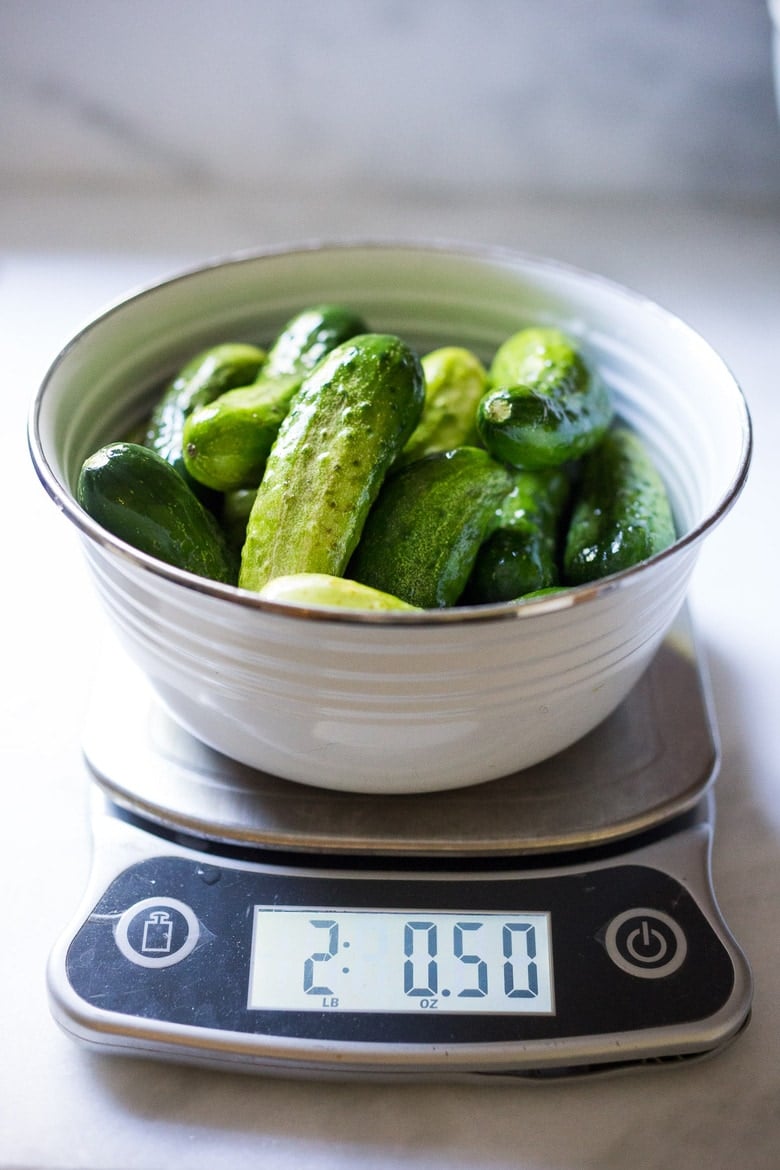
What you’ll need
- Pickling Cucumbers- Small and short (4 inches long) with thin bumpy skin, crisp texture, small seeds, a blocky shape and color gradient from light to dark. Varieties include Kirby, Calypso, Royal, Pickalot, National Picking, Adam Gherkin, Sassy, Eurika, Jackson, Boston Pickling, Northern Pickling… to name a few. You’ll need 2 lbs of “pickling cucumbers.” This recipe makes one large 1/2 gallon jar (or use two quart-sized jars) – a relatively small batch. Pickling cucumbers are most easily found at your local farmers’ market. Ask the farmers if they have “pickling cucumbers” they can help direct you to the right ones. Your pickles will only be as good as your cucumbers, so choose wisely! Make sure they are roughly the same size -about 4 inches long with 1 1/2-inch to 2-inch diameters – so they fit in the jar nicely and ferment at the same rate. I handpicked each one. They should be fresh and crisp with no soft spots.
- Salt-use fine sea salt, or fine Himalayan Pink salt
- Garlic and Onion – we load this up with 10-20 garlic cloves for the best flavor!
- Fresh Dill – use a big handful!
- Spices: Ground Turmeric ( adds fresh flavor) fennel seeds, mustard seeds, whole peppercorns, coriander seeds, whole allspice, dill seeds and celery seeds. Feel free to change or embellish! I added a couple of chilies for a little heat.
- Optional Tannic Acid: Bay leaves, grape leaves, oak leaves, or a couple of slices of fresh horseradish root. Cucumbers contain enzymes that soften them. To prevent this add a few bay leaves or a grape leaf to the jar.
- Two-Quart Mason Jar ( 8 cup mason jar)
- Fermentation weights
- Optional: Air lock, gasket, metal ring
How long does it take to ferment pickles?
These 3% Brined, half-sour crunchy pickles take 3-5 days of fermenting time.
The Brine: SALT TO WATER RATIO
- This recipe is a 3% salt water brine, which is considered “safe”. It equals 7 grams of salt per 1 cup of water. Or, 1 heaping teaspoon salt (1 1/4 teaspoon salt ) per 1 cup of water. This ratio allows one to drink the brine (like a shot) because it is not too salty and is designed for a shorter fermentation period ( 3-5 days). Crunchy, lightly fermented pickles!
- If you want a stronger brine for a longer ferment, feel free to go up to 4.5%. So for example, 3.5% Ratio= 9 grams of salt per 1 cup of water, 4.5% brine =10.8 grams of salt per 1 cup of water. For a 4.5% brine, half-sour pickles take 5-7 days, full sour pickles 14-21 days.
Fermented Pickles (step-by-step Instructions)
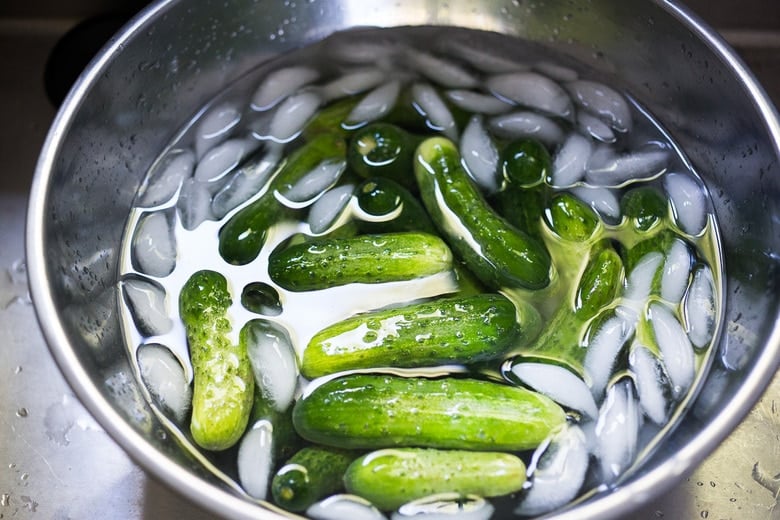
Step 1: Wash the cucumbers, slice off 1/16 inch of the blossom end, and soak them in an ice bath for 15-30 minutes to firm and crisp them up. There are enzymes in the blossom end that can make your pickles soft, so be sure to remove them.
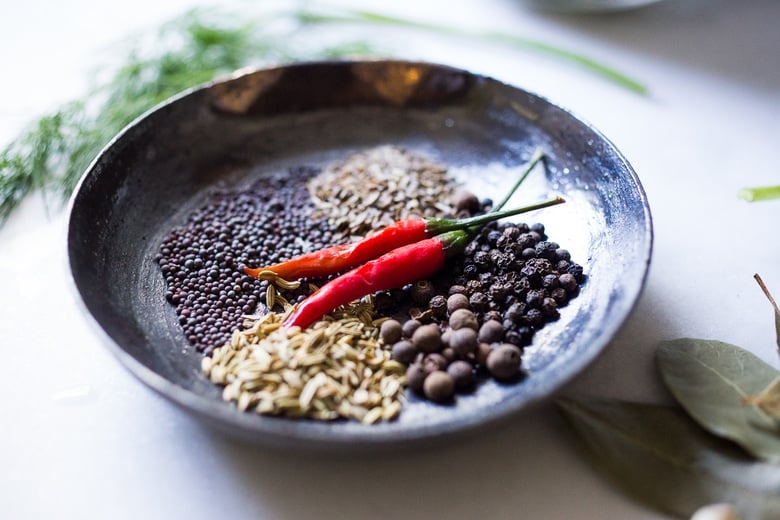
Step 2: Slice the garlic lengthwise and gather your spices.
Because these fermented pickles are left whole, you want the brine to be extra flavorful. I add a lot of garlic… 10-15 cloves, sometimes 20! Fermented Garlic is really good for the gut too!
Step 3: Place the spices on the bottom of the jar, then sliced garlic, fresh dill and bay leaves, and then add 2 layers of cucumbers, end on end, in a large two-quart jar (half-gallon). Press everything down.
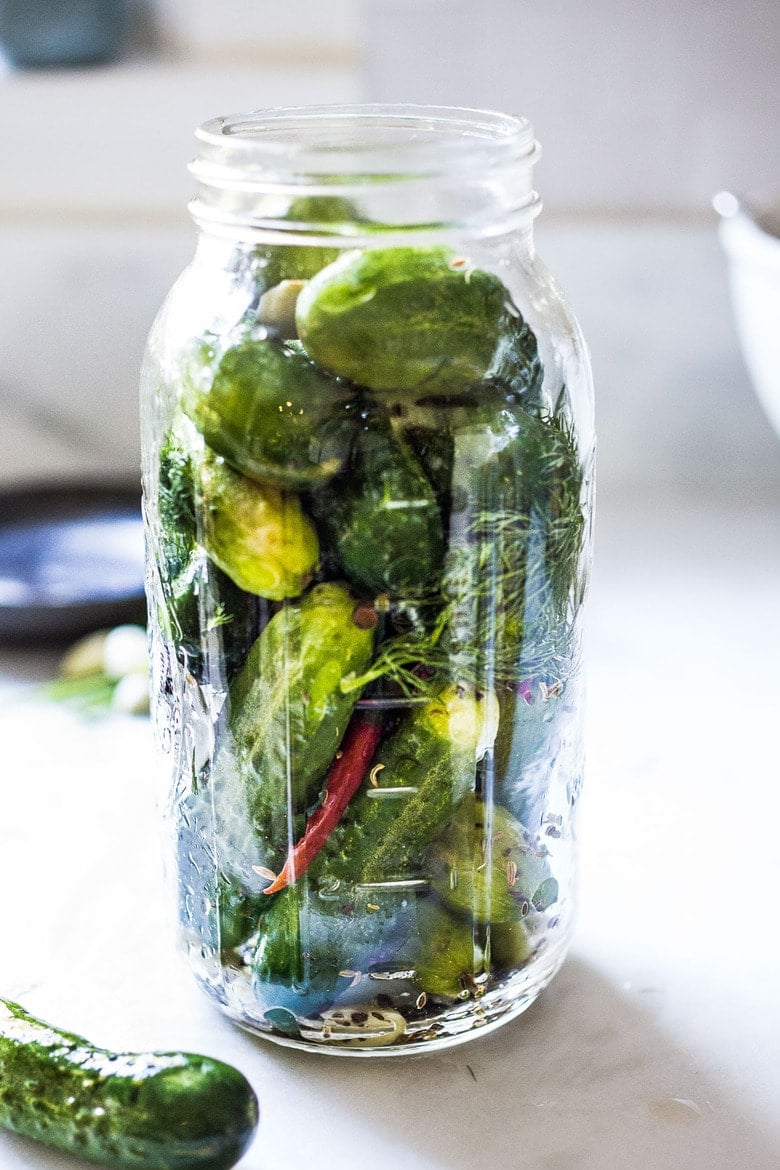
Step 4: Carefully measure and mix salt and water to create the 3% salt water brine- then pour this brine over the pickles leaving 1 1/2 inches of headroom.
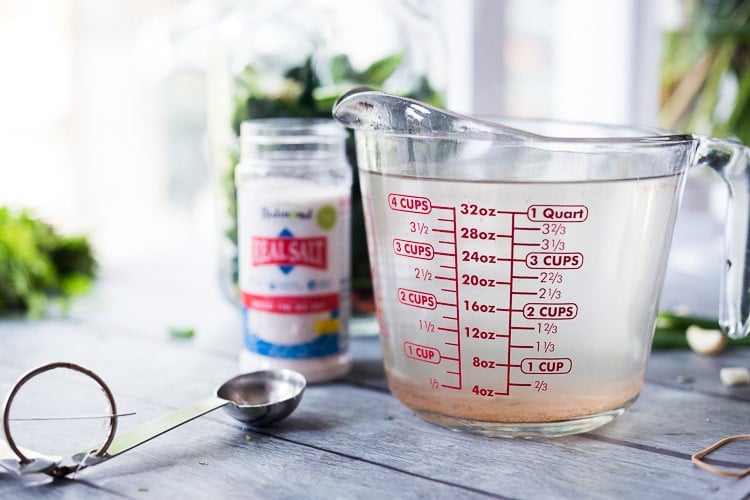
How salt works in fermentation:
- In a nutshell, using the right ratio of salt in fermentation encourages the growth of healthy bacteria while at the same time killing off bad bacteria. You want to be precise when measuring the salt and water in these kinds of recipes.
- Too much salt may kill off ALL of the bacteria -preventing fermentation.
- Too little salt will allow bad bacteria to keep on living. It is a fine balance. 😉
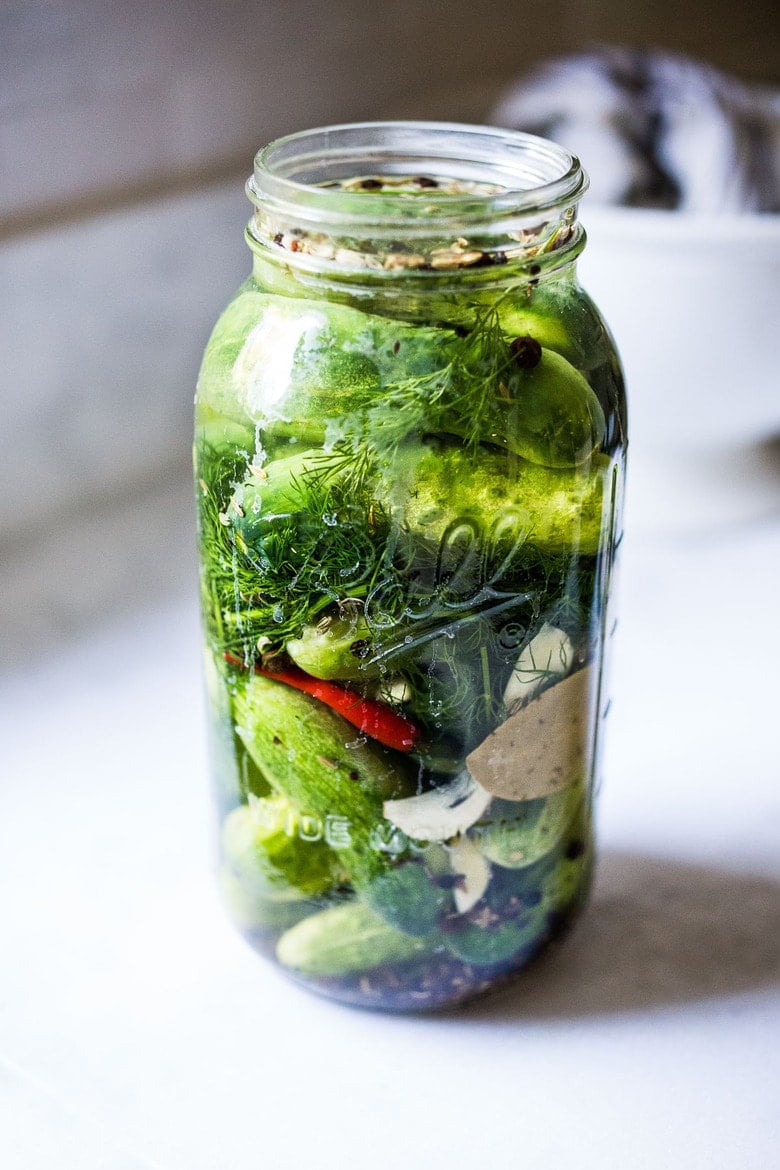
Step 5: Weigh down the cucumbers so they are completely submerged under the liquid, using a couple of fermentation weights, or a small zip lock bag filled with a little water (in a pinch).
MOLD: If the cucumbers or seeds are not submerged under the brine and become exposed to air- they can develop mold, so spoon any floaters out with a slotted spoon. Most seeds should stay submerged.
Step 6: Cover loosely with a lid or towel (to prevent bugs or flies from coming in, and to allow gases to escape) place in a bowl or pan to catch any overflow, and place in a cool dark place for 3-7 days, like the basement. You can also use and airlock lid- which allows air to escape, but nothing to fly in.
Step 7: Check after 2-3 days. Look for signs of life: bubbles/ or cloudy water. A cloudy brine is GOOD. Tap the jar and see if bubbles rise to the top. Check to see if any brine overflowed into the bowl ( both signs of life). This often takes about 3-5 days, I find 4 days is the “sweet spot”, depending on temperature. Cloudy brine is delicious and nutritious!
Step 8: Place the jar in the fridge to further slow the fermentation with a loose lid. They will continue to ferment very slowly and will keep indefinitely.
Expert Tips:
- Ferment at cooler temps (60-70F) to keep pickles crisp. If your home is hot, try placing in a cooler with ice. Take the temp of the brine.
- The longer you ferment them (unrefrigerated), the tangier they will get. But they will also get softer. I like them crisp, but you may want them tangier and softer. You can taste them at any point after you see bubbles.
- Smell: your ferment should smell tangy, garlic and fresh. If you notice anything foul or unpleasant, your ferment may have been contaminated: most commonly by dirty hands, dirty utensils, or a dirty jar.
- If you want to create a “fizzy” brine for drinking, tighten the lid, and burp daily if leaving out. You can tighten the lid in the fridge, but burp weekly. This will create a little pressure and give it some effervescence.
- Anything that touches air- may mold. Always fish out any floating spices with a slotted spoon to prevent this.
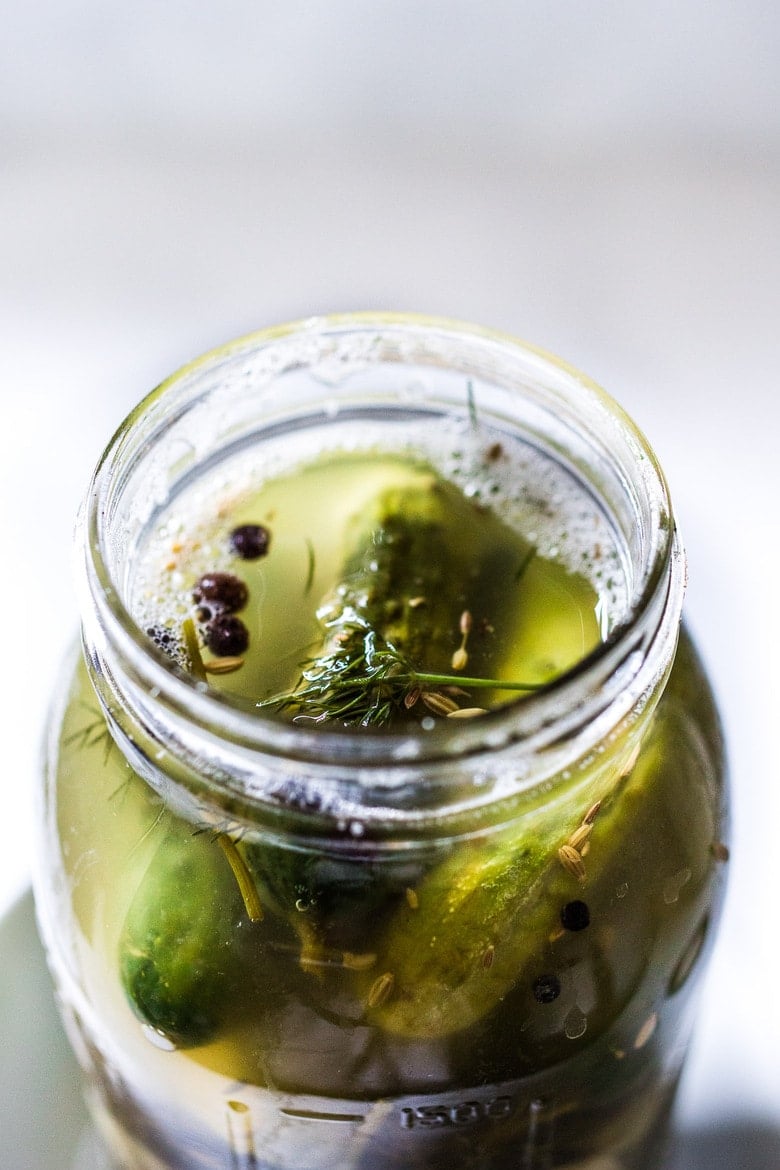
Once they are cold, give them a taste. They should be crunchy and flavorful! The brine is deliciously tangy, salty, and effervescent -so tasty and full of gut-supporting probiotics. The garlic is tasty too! Eat it!
I find myself often drinking shots of the brine! I also make this Gin & Brine Martini!
Let me know how you like this one in the comments below!
xoxoxo
More Favorite Ferments!
- Curtido & Cultured Salvadoran Slaw
- How to make Sauerkraut (Simple Cultured Cabbage)
- Beet and Cabbage Sauerkraut
- Cucumber Kimchi Pickles
- Turmeric Sauerkraut
More from Feasting at Home
How to make Fermented Pickles| 45-sec video
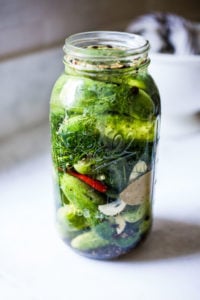
Homemade Pickles with Garlic and Dill
- Prep Time: 4 days
- Total Time: 4 days
- Yield: ½ gallon
- Category: fermented, preserved
- Method: fermented
- Cuisine: American
- Diet: Vegan
Description
How to make Manhattan-style, fermented Dill Pickles! A simple recipe for making the most flavorful, crunchy, tangy, garlic dill pickles with only 15 minutes of hands-on time. Full of healthy, gut-healing probiotics these little guys are perfect as a low-calorie snack, or sliced and added to sandwiches.
Ingredients
- 2– 2 1/2 lbs pickling cucumbers– all similar size ( 5 inches)
- 5 cups filtered water or tap water (that is not overly chlorinated)
- 2 tablespoons fine sea salt or Himalayan salt — or basically one heaping teaspoon fine sea salt (7 grams) per one cup of water, for a 3% brine (see notes)
- 1/4 teaspoon turmeric (optional, adds a “fresh” flavor)
- 1 teaspoon each: fennel seeds, coriander seeds, allspice, peppercorns, dill seeds, mustard seeds, celery seeds- and feel free to add more peppercorns!
- 10–20 garlic cloves, sliced (or double for extra garlicky)
- 1/2 onion, thinly sliced (optional)
- big handful of fresh dill
- 1–3 fresh red chilies – or dried arbol chilies, or add chili flakes (all optional)
- 3–4 bay leaves (or a grape leaf or oakleaf) – these are sources of tannic acid to help them stay crisp.
You’ll need a 1/2 gallon mason jar, crock, or 2 quart-sized jars- clean and sterile.
Instructions
- Prep Cucumbers: Rinse the cucumbers, remove 1/16-inch of the flower end of each cucumber (keeps them from getting soft) and place them in an ice-water bath, to crisp them up (15-30 minutes). Leave them whole.
- Make the brine: Mix salt (2 tablespoons) and 5 cups cold water until dissolved.
- Wash your hands, jar and any utensils. No need to sterilize, just clean!
- Assemble: In a large, clean two-quart mason jar, place all the whole spices into the bottom. Add the dill, garlic and onions or turmeric if using. With clean hands, pack one layer of cucumbers tightly, standing on end, then add the bay leaves, then add the second layer of cucumbers standing on end.
- Press everything down, leaving 1 ½ inches of headroom. Pour the salt water brine over the top and weigh down the cucumbers with fermentation weights so they are submerged under the brine. Remove any spices that may have floated to the surface (which can mold).
- Cover the jar loosely with a lid or with a cloth- basically, the pickles will bubble and you want air to be able to escape.
- Place the jar in a pan or bowl to collect any overflow and leave it in a cool dark place (60-70F) for 2 -3 days (a basement, or lower kitchen cupboard) and check for bubbles or overflow, indicating fermentation. Half sour pickles will take 3-5 days with crisp, white interiors. If is colder than 65F, it may take longer, if hotter, they will ferment faster. Full sour pickles will take 14-21 days (see notes for a stronger saltwater ratio).
- After 2 days, check for signs of life: bubbles, overflow, or clouding. Tap the jar, and see if tiny bubbles rise to the top. I usually ferment for 3-5 days. Longer ferments will yield tangier pickles but will get softer as they ferment, and lose their vibrant color. Up to you. You can taste them at any point after you see bubbles, and ferment longer if you like. The brine will get cloudy as it ferments- this is a good sign! Once you see active bubbles, you can at this point place the jar in the fridge, where it will continue to ferment, but much more slowly. Keep the pickles submerged.
- Once chilled, give them taste. They should be crispy and flavorful with a little tang. (At this point, if you want a tangier or softer pickle, you can absolutely pull them back out again and ferment for a few more days longer if you want.)
- If you like fizzy brine, tighten the lid, burping every week or so or try using an airlock. If you don’t want to think about it, give the lid one loose twist, so it’s on there, but gases can escape.
Notes
If you need more brine, make sure you use the same ratio- 1 heaping teaspoon sea salt per one cup of water.
If using a grape leaf, place it on the side of the jar, then layer the remaining ingredients.
If pickles turn out too soft- it may be due to too warm of temperature during fermentation, or the flower end wasn’t removed (the flower end of the cucumber has enzymes that can soften pickles).
Feel free to use 2, quart-size jars, dividing cucumbers, spices and brine between the jars.
BRINE: This recipe is a 3% salt water brine, which is considered “safe”. It equals 7 grams of salt per one cup of water. I’ve had really good luck with this ratio – and this ratio allows me to drink the brine (like a shot) this is really healthy – full of good gut-supporting bacteria!
If you want a stronger, saltier brine, feel free to go up to 4.5%. For a full sour pickle (14-21 days) use a 4.5% brine.
- 3% ratio = 7 grams salt per 1 cup of water. (1 1/4 teaspoon fine sea salt, per 1 cup water)
- 3.5% Ratio= 9 grams of salt per 1 cup of water. (1 1/2 teaspoon fine sea salt, per 1 cup water)
- 4.5% ratio 10.8 grams of salt per 1 cup of water. (2 teaspoons per cup of water)
Cutting the Cucumbers: I recommend leaving them whole. The texture is much better. After your first successful batch, feel free to experiment.
Nutrition
- Serving Size:
- Calories: 16
- Sugar: 1.3 g
- Sodium: 297.4 mg
- Fat: 0.2 g
- Saturated Fat: 0 g
- Carbohydrates: 3.7 g
- Fiber: 0.5 g
- Protein: 0.7 g
- Cholesterol: 0 mg
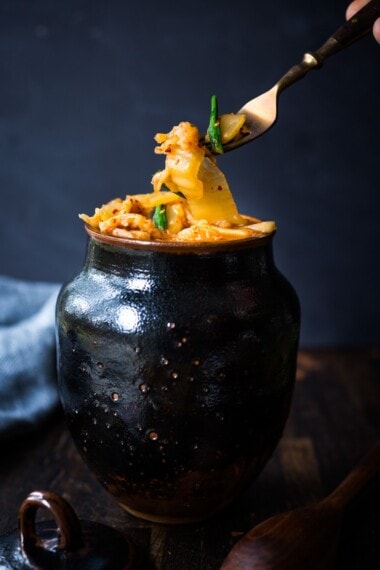
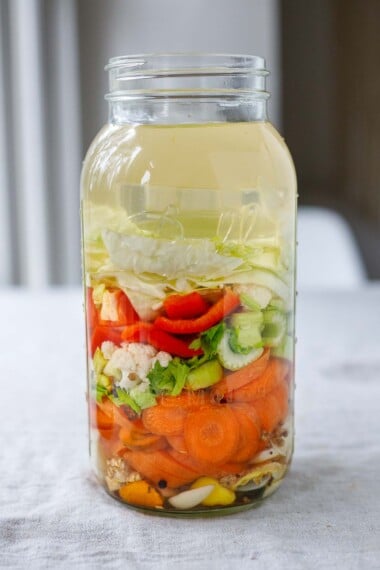
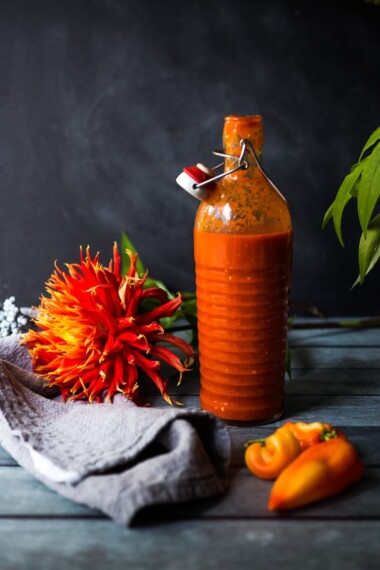
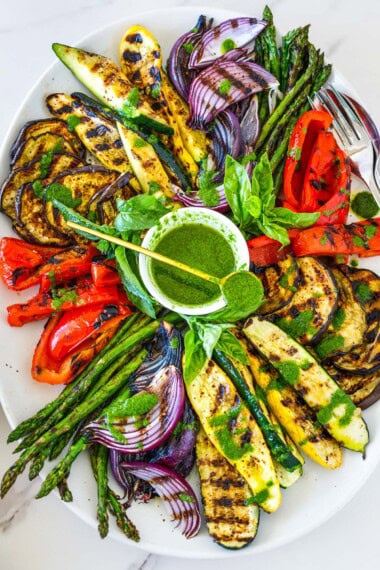



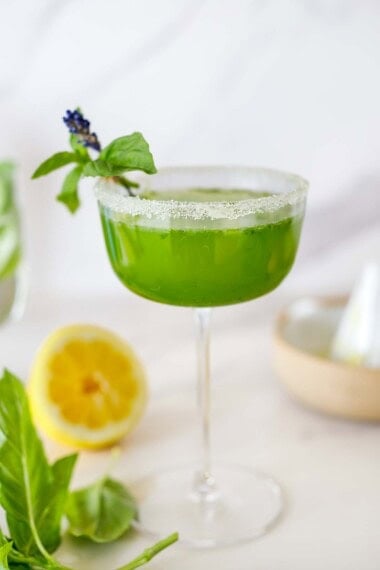
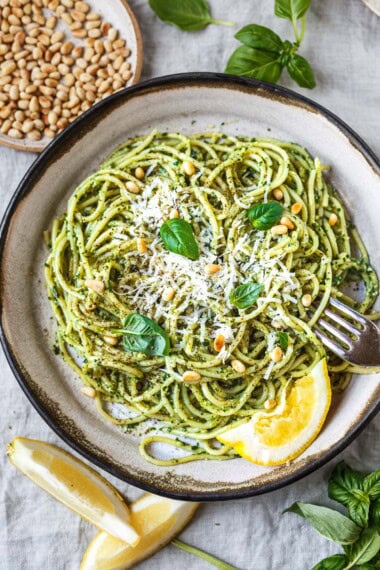
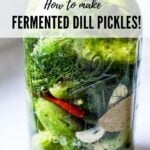
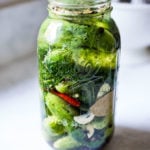
These pickles taste just like the ones my grandpa used to make when we were kids ages ago !!! I tried your recipe and WOW they taste just like grandpa’s 😋😋 I tried making them before and just couldn’t get it right so now I am very pleased with your recipe . Thanks !!
I am so glad they brought back happy memories!
really useful info. Love making things like pickles and kraut the original way without vinegar. Vinegar has it’s place but the health benefits of natural brine is what I’d prefer. Thank you!
I agree~!
These looked and smelled so good when I made them, but when I checked on them 5 days later, both jars had mould growing on the top. I followed the recipe and directions exactly, and had them in my basement so they shouldn’t have been too warm. What did I do wrong?
Oh shoot. Did you add weights? Didthe or cucumbers seeds float to the top? Mold usually only grows if something is above the brine in contact with air.
I did use room temp after using a little hot water to dissolve the salt. No Mold and the brine tastes good. I had larger cucs so cut them and the main pulp of the cucs became soft but I did 3 things wrong. Brined for 8 days and at room temp upstairs but also had the lids on… too tight. My first effort. There’re still very tasty and won’t go to waste ! : )
Hey Graham- glad they taste ok! Don’t cut and ferment for 3-5 days to improve texture next time. 🙂
I Use 2.5 teaspoons salt per quart sealer and .9 of a 500 ml bottled water per sealer which equals 2 cups perfectly. What I don’t know is should the water when added to the jar be room temperature or hot. That was not clear.
Thanks Graham! Water shoot be room temp or cold. Not hot. 🙂
My cucumbers are a bit bigger than when I made my last 2 1/2 gallons of these amazing pickles and wondered if leaving them whole is the key to a crisper pickle. Have you ever cut in spears to ferment with this recipe?
Thanks again for the recipe!
I have, and they are better (crispier) left whole in my opinion!
Thanks for responding.
You said “Non chlorinated tap water…” I believe you meant Non filtered tap water.
Hi, sorry for the confusion- I mean tap water that is not overly chlorinated. 🙂
There are a few online recipe blogs online I love. You are one of them. Thank you for having jump to recipe when I am in a hurry!!! D
Yay Denise! Thanks!
Can you reuse the brine if kept refrigerated?
I think it has been done but we usually start fresh, just to be on the safe side. You can add a couple of tablespoons from the old brine into the new to kick-start the ferment. We like adding the leftover brine to cocktails and just drinking on its own as a probiotic tonic!
best ever and crispy with current leaves too.
Oh good to know!
Been trying other fermented dills the past years but the ease, flavor and just the sheer beauty in a gallon jar makes them my new fav! Thank you for this recipe. Going to have to try the gin and (fermented tonic) you have on your blog.
Thanks Lois! Glad this worked for you!
These are hands down the best pickles we ever made and to think we get probiotics as well. I omitted the onion and used all the garlic you called for. My spices were a dry chile sans seeds, mustard seed, black pepper, bay leaf (essential) juniper berries, allspice. And I did add the turmeric. I cut off the blossom ends as you directed.
Used an air lock.
At day 3 they were good. Day 4 better and they went into the fridge. After chilling they were so crisp. Just perfect.
This time I’m switching from sea salt (I’m out) to pickling and canning salt. No iodine.
When I weigh it, the volume seems like such a small amount of salt, 42 grams for 6 cups filtered water, only about 5 teaspoons. So I’m measuring—6 heaping teaspoons per cup of water. I’m hoping the brine will still be 3%.
Thank you for a well thought out, easy and scientific way to make yummy pickles.
Thanks so much Gram- glad you gave these a go! I am making some now as well! Love them!
What does this mean? 2 tablespoons total or 2 per cup, i.e., 10 T?
“2 tablespoons fine sea salt or Himalayan salt — or basically one heaping teaspoon fine sea salt (7 grams) per one cup of water, for a 3% brine (see notes)
Hi Len, to make a 3% brine, add 1 teaspoon per cup of water, or 6 teaspoons (2 tablespoons) per 6 cups water.
Love the crunchiness!
Glad you enjoyed these Chaba!
I made a batch of these for a test run as my first fermented pickles. I’ve made refrigerator and canned pickles for years. I’ve made sauerkraut once too. I’m excited to taste the results. One mistake I made was adding dry dill weed. Do not recommend as the dill floated to the top making it susceptible to mold. I had to dump the brine and rinse the cukes to start over without the dill and added just the seeds. Next time I’ll add fresh. I also, saw a recipe where they added a few tablespoons of apple cider vinegar for added tang. I did the same. Wish me luck!
Hi Kerrie- Glad you gave this a go! For next time, I highly recommend adding the AC vinegar after the fermenting process- They naturally get tangy when they ferment, and it’s a good way to determine if they are actually fermenting. You can always bump up acidity after.:)
Hi. I’m in the middle of making these and just wondering if there’s a way to can these for use down the road, can the juice be heated and the dills put in hot sterilized jars? Or is this just a refrigerator pickle ? Thanks, and my kitchen smells like heaven, day 4
Hey Sally- it really defeats the purpose of fermenting, so I can’t recommend it. Heating will kill off all the probiotics. I would keep it in the fridge.
Love this recipe! Just in time for my garden veggies too. Thank you so your amazing recipe, Sylvia! ❤️❤️
Thanks Suwanee!
I need a recipe I could can but I can’t find one. I don’t have room in the fridge for a lot of pickle jars.
Your recipe does sound good though.
Yes, this is not a canning recipe, sorry Pamela!
Have you ever added Honey into the mix with peppers to get a sweet/spicy pickle?
Interesting Jason, I have not ever done this! I wonder if it would alter the fermenting process and turn more into alcohol (like Mead)? I would try adding the honey after the fermenting has done its thing and then let it sit in the fridge for a couple of days to infuse. Sounds like a fun experiment!
Hi Tonia, hi Jason, I have made this recipe and added a tbsp of honey — because that is how my Ukrainian auntie who taught me how to make “countertop” pickles always did it! I can attest that the honey works. I am no chemist but I think it’s the “good” bacteria in honey that helps in the fermentation process. I have also tried skipping the honey and adding a little kefir — again, for the good probiotics. I’ve had success with both ways. For me, 2 key takeaways from this recipe are the turmeric for that little “kick” of fresh flavour and moving my pickles off the countertop to my cool basement! And yes, the grape leaves work like a charm for crispy pickles. Thanks, Tonia.
Thanks Loreen! Interesting addition with the honey. I’ll have to try it!
wow, have made many Dilpickles with vinegar . No more !!
Fermenting is so much easier and faster
And healthier! Glad you gave it a go!
I liked the detailed explanation about making the brine, thank you
Thanks and glad it helped!
I’m going to start these tomorrow! I know it’s 4 years since you posted this, but for the record, it appears your scales shows 2lbs, 1/2 oz, not 2 lbs, 8oz, which would be 2 1/2 lbs.😉
For the person avoiding seeds: you could put them in a cheesecloth bag so you get the flavor, but can remove them so you don’t eat any.
Great idea Veronica!
How long will these last when following your instructions?
Indefinitely in the fridge.
Thank you for your quick reply.
I’d say indefinitely, in the fridge, if you have fridge space! But they’re so delicious and crispy, I promise a jar will disappear the same day you put them out!
I have been making my mother’s kosher dill pickle recipe for more than 40 years. The recipe is similar in that you make the brine and add dill and spices (and fresh garlic) to the jars and then store the jars in a cool place. I am wondering why you would choose sea salt over kosher salt for pickles.
Hi Nancy, feel free to use kosher; it’s fine! I personally switched to sea salt (actually the salt I have linked is not from the sea, it’s from a salt mine) because it has a higher mineral content than kosher. This brand REAL Salt has the highest mineral content I can find, which is why I recommend it. Health reasons 🙂
Can these be made w/out all the seeds, just garlic and dill? I’m following the AIP diet and seeds are not allowed although I do want those healthy ferments. Thanks.
Yes of course!
Thank you for this🥰
Love your site.
I have 2 questions:
To keep the veggies as long as possible crispy and due to the fact that cool temperatures leed to slow down the process can it start in the refrigerator Friday one on?
Did you ever use Aspirin for preventing mould and if so, how?
Thank you for reading this.
Now I will go on reading further here. (I hope you have a book to buy🤞)
Greetings 👋
Thanks JM, I have never used aspirin, and great question about the fridge. I don’t know the answer to this. Does anyone else?
I’m just starting to make these pickles but I only have a 1 gallon jar so I’m going to double the recipe and hope it turns out
That should work fine, just get them below the brine. 🙂